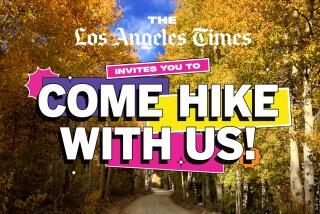Beauty Can Mask Risks
At the northernmost tip of Cleveland National Forest, the brush is thick, and the rocky Santa Ana Mountains give way to steep canyons and meandering creeks.
This dramatic terrain is scenic, but Judy Behrens, public-services manager for the Trabuco Ranger District, said it is filled with hazards as well.
Consider:
* The soil is decomposed granite, coarse and sandy. It may give out from under a hiker not paying attention.
* Off-trail wandering is dangerous because the thick brush hides sudden drop-offs.
* Lost hikers following the creek bed face another danger. Oaks and sycamores line the creek beds and can hide hikers from the eyes of a helicopter search crew.
“Hikers think ‘If I keep moving, I’ll find a trail. I’ll find a creek and follow it out.’ But that’s when they get in trouble,” Behrens said. “You can spend time without food, but not without water. I’m sure that it’s frightening when you’re lost, and human nature says ‘I have to find my way back,’ but [roaming in search of a way out is] not safe.”
Parks officials said hikers frequently stray from the path. Most find their way back within minutes.
But occasionally, things get more serious. A hiker gets lost in the woods for a day, spends a chilly night lost and frightened--or worse.
Past Hiking Deaths
The last Orange County hiking death occurred in early June when five friends went into the Cleveland National Forest. One fell down a rock face and died. Two in the group got lost while trying to go for help.
Tim Miller, manager of Orange County’s Harbors, Beaches and Parks division, said a year earlier a man got lost at Ronald Caspers Wilderness Park and ended up camping in the park overnight.
Another time, a young man in his mid-20s stepped off a trail in Aliso and Wood Canyons Wilderness Park. He died climbing up a steep bank, trying to find his way back.
“If [hikers] follow the rules, it’s highly unlikely they’ll get lost,” Miller said. “But if you do have people stepping off of the trail, the problem is twofold. One is their safety, another is the safety of wildlife.
“If you have people off trails on their own, they’re hurting their own safety and jeopardizing the environment.”
Recently, Behrens has seen more hikers take cellular phones and global-positioning equipment into the woods, but she warns that not even these can keep hikers safe in this terrain.
Cell phones and even hand-held radios fail to work in low areas such as the Upper San Juan Campground off the Ortega Highway. Signals from microwave towers cannot get through.
Global-positioning systems receive satellite signals, and although Behrens hasn’t heard of reception problems, they are not pinpoint accurate. And in the forest’s steep terrain, a distance miscalculation could be the difference between safety and a nasty fall.
Stay on the Trail
Behrens’ best advice is to stay on the trail and bring a gallon of water just in case. If taking a cellular phone, be sure the battery is fully charged, and don’t expect to be able to use it throughout the hike.
Give friends and family an itinerary. Park employees cannot keep track of visitors, even if they sign lists at designated booths. Though about 100 volunteer hikers, equestrian groups and mountain bikers keep an eye on the area, only one park employee roams the 135,000 acres of Cleveland National Forest. She picks up the sign-in list only once a week.
And most important, if you’re lost, stay in one area. Signal for help by shouting, blowing a whistle or reflecting light from a mirror.
“It’s enjoyable to be out and a whole lot of fun. But you need to be safety conscious because Mother Nature is not really kind,” Behrens said.
(BEGIN TEXT OF INFOBOX / INFOGRAPHIC)
A Hiking Checklist
Many hikers prefer to bring as few items as possible as they transverse the hills and canyons of Orange County. But officials said to ensure safety, there are many obvious--and some exotic--gear to bring along.
BASICS
* Candle
* Clothing (always bring something warm, extra socks, and rain gear)
* Compass
* First aid kit
* Food (bring extra)
* Flashlight
* Hat
* Insect repellent
* Map
* Nylon filament
* Pocket knife
* Prescription glasses
* Prescription medications for ongoing medical conditions
* Radio with batteries
* Space blanket or a piece of plastic (to use for warmth or shelter)
* Sunglasses
* Sunscreen
* Water
HIGH TECH
* Walkie-talkies
* Cellular phone
* Global Positioning Systems
EXOTICS
* Trash bag (makes an adequate poncho)
* Pocket mirror (to use as a signaling device)
* Waterproof matches or matches in a waterproof tin
* Water purification tablets
* Whistle (to scare off animals or to use as a signaling device) * Foil (to use as a cup or signaling device)
More to Read
Sign up for The Wild
We’ll help you find the best places to hike, bike and run, as well as the perfect silent spots for meditation and yoga.
You may occasionally receive promotional content from the Los Angeles Times.






